Queen Helen Nemanjić (?–Brnjaci near Zubin Potok, February 8, 1314) was a Serbian medieval queen and consort of King Stefan Uroš I (r. 1243–1276), the fifth ruler of the Serbian Nemanide dynasty. She was the mother of the kings Stefan Dragutin and Stefan Uroš II Milutin. Today, she is known as Helen of Anjou (Jelena Anžujska in Serbian) although her real name was most probably Heleni Angelina (Ελένη Aγγελίνα). She was the founder of the Serbian Orthodox monastery of Gradac as well as four Franciscan abbeys in Kotor, Bar, Ulcinj, and Shkodër. Together with her sons, Kings Stefan Dragutin and Stefan Uroš II Milutin she helpedrenovation of Benedictine abbey of Sts. Sergius and Bacchus near Shkodër on Boyana river in present-day Albania. After the death of her husband, she ruled Zeta and Travunija until 1306. She was known for her religious tolerance and charitable and educational endeavors. She was elevated to sainthood by the Serbian Orthodox Church. Along with Empress Helen, the wife of Serbian Emperor Stefan Uroš IV Dušan, Queen Helen was the most frequently painted woman of Serbian medieval art. Six of her portraits can be found in the monumental painting ensembles of the Serbian medieval monasteries of Sopoćani, Gradac, Arilje, Đurđevi Stupovi (Pillars of St. George), and Gračanica, as well as on two icons and one seal. Queen Helen is also the only female Serbian medieval ruler whose vita was included in the famous collection of the “Lives of Serbian Kings and Archbishops” by Archbishop Danilo II, a prominent church leader, warrior, and writer.
- Helen of Anjou
- Nemanide dynasty
- Sopoćani Monastery
- Gradac Monastery
- Queen Helen’s seal
- Vatican icon
- Gračanica Monastery.
1. Introduction
2. The Sopoćani Monastery
Painted between 1263–1268 [7] (p. 18), the figure of Queen Helen appears twice in the Holy Trinity Church of the Sopoćani Monastery, the endowment of King Stefan Uroš I, built from 1259 to 1270, near the source of the Raška River in the region of Ras, the center of the Serbian medieval state, located 15 km west of the present-day town of Novi Pazar. In the narthex, King Stefan Uroš I’s royal family is shown standing in front of the Mother of God with Christ. King Stefan Uroš I is depicted with their eldest son, Stefan Dragutin, heir to the throne, on the southern part of the eastern wall of the narthex, while Queen Helen is shown behind him, on the southern wall, with their younger son, Stefan Uroš II Milutin (Figure 1). From an iconographical point of view, this is not a founder’s composition but a portrait of the royal family, which is the first of its kind in Serbian medieval painting. Helen is shown as a tall, beautiful young woman with a crown on her head. She is dressed in the Byzantine manner, in a purple divitision (διβητήσιoν) decorated with a wide collar—a maniakon (μᾰνῐᾰќῐον). On the front, the dress is decorated with a loros (λῶρος)—a wide decorated ribbon wound around the torso so that one end hung down in front and and the other hung over the right arm. The loros is decorated with precious stones and pearl wreaths. On the side of the dress there is a circular decoration—rota—a motif that dates back to Antiquity. Queen Helen is wearing a simple and open crown—a stemma (στέμμα).
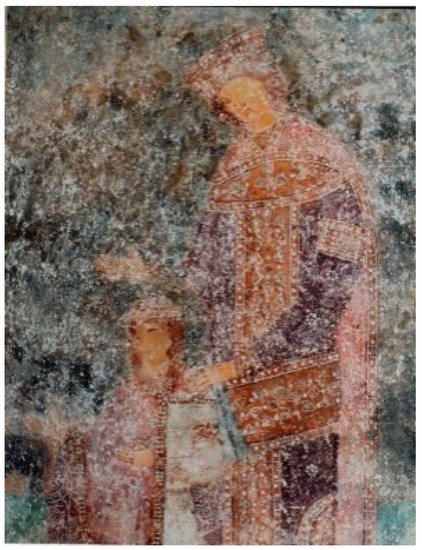
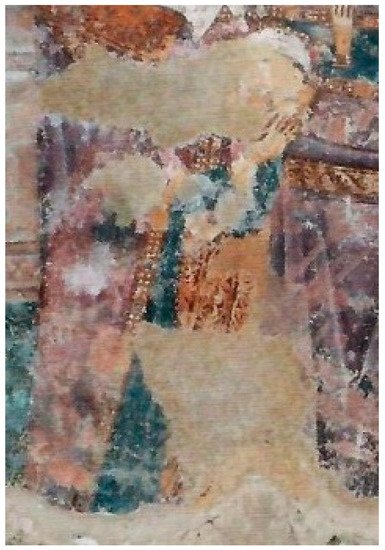
3. The Gradac Monastery
Queen Helen is depicted in the Church of the Annunciation at the Monastery of Gradac. The Annunciation Church of the Gradac Monastery (Figure 3) was her endowment, built around 1275 on the elevated plateau above the Gradačka river at the edge of the forested slopes of Mt. Golija, 12 km to the west of the medieval fortress of Brvenik. Although the overall ensemble of the wall paintings of the Gradac Monastery was largely damaged, a founder’s composition was once depicted on the south wall of the western part of the nave, above a double tomb [10] (p. 81). It is still possible to distinguish several figures from the outlines: the Mother of God presents a monk to the enthroned Christ, followed by King Stefan Uroš I and Queen Helen. Together they are holding a model of the church (Figure 4). Queen Helen is represented in a full-frontal position, usually reserved only for Byzantine emperors [8] (p. 28), which led Danica Popović to the conclusion that she was the first founder [10] (p. 85). The fresco was largely destroyed and today is mostly unrecognizable. However, it is possible to see that Helen is wearing an open crown on her head. Traces of a halo around her head are also visible.
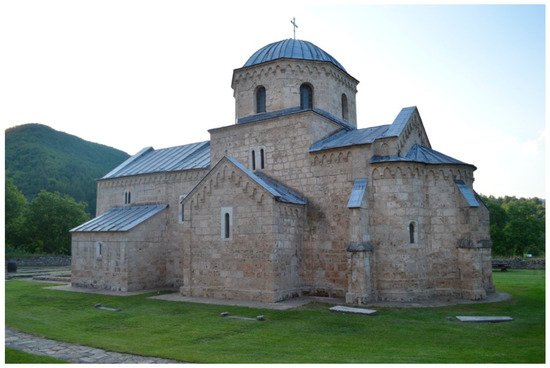
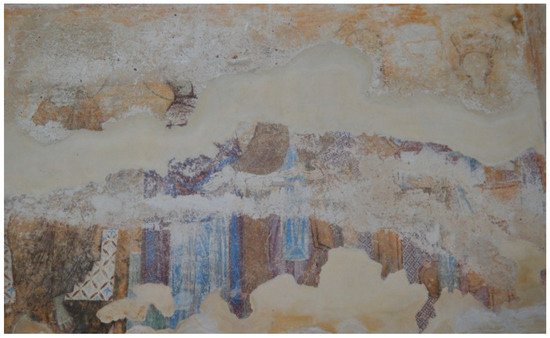
4. Queen Helen’s Royal Seal
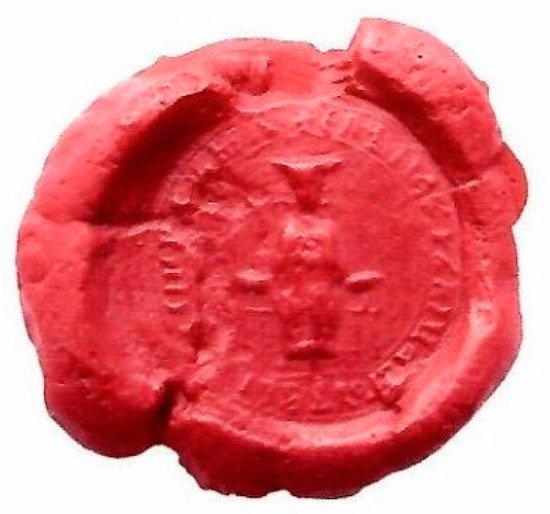
5. The Monastery of Đurđevi Stupovi (Pillars of St. George), Chapel of King Dragutin
The Monastery of Đurđevi Stupovi (Pillars of St. George—pillar being called stolp, in Old Church Slavonic) was erected in about 1170 as an endowment of Grand Prince Stefan Nemanja and dedicated to St. George. The monastery is located near the present-day town of Novi Pazar in the Serbian region of Ras, on the top of a prominent elevation covered with forest. The monastery complex consisted of the Church of Saint George, dining room, refectory, water tanks, and walls around the entrance tower. After the additional construction of apse in the east side in 1282–1283, the entrance tower was turned into a chapel that King Dragutin designed for his tomb (Figure 6). The inside of the chapel is covered in frescos with historical content. Another founder’s composition was depicted there. On the south wall of the chapel, a procession of Nemanide monks is approaching Christ on the throne: Symeon Nemanja, Stefan the First-crowned as the monk Simon, King Uroš as the monk Symeon, and Queen Helen. For the first time in Serbian 13th century iconography, a procession of patron saints, i.e., the Horizontal genealogy of the Nemanide family is interrupted, and the founder of the church is represented not after his saintly predecessors but on the other, western wall. Queen Helen (Figure 7) is depicted wearing a monastic habit and a white veil, either as a novice or as sign of mourning, and a halo around her head. On the left side, next to her head, is an inscription that reads: IЄЛѢHA BEЛИKA KPAЛIЦA [Helen, the great queen].
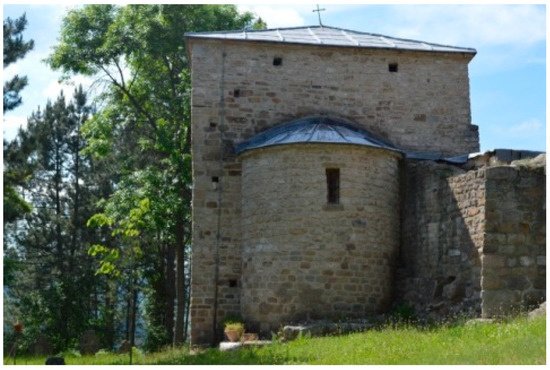

6. Church of St. Achillius in Arilje
The Church of St. Achillius is located in the center of the town of Arilje in western Serbia. It was built as the main endowment of King Dragutin, Queen’s Helen elder son. According to the preserved inscription, the church was painted around 1295/97 [12] (p. 95), i.e., fifteen years after King Dragutin abdicated in favor of his younger brother Milutin in 1282. Queen Helen is depicted on the south wall of the nave at the back of the Nemanide procession, led before Christ by Stefan the First-crowned as the monk Simon, followed by King Uroš I as the monk Symeon. She is painted wearing a monastic habit (Figure 8) with a halo around her head and an inscription on both sides of the figure that reads: IЄЛЄHA KPAЛIЦA BЬCЄ CPЬCKIЄ 3EMЛЄ [Helen, the queen of all Serbian lands]. Common belief has it that the reign of Dragutin lasted from 1276 to 1282. Recently, this was questioned by Vlada Stanković who assumes that instead of the brothers and their mother reigning separately, there was a “peculiar (ruling) triumvirate” of King Dragutin, Milutin, and Queen Helen that lasted from the abdication of King Uroš I in 1276 to Milutin’s peace agreement with the Byzantines in 1299 [2] (p. 69). This fact could better explain the appearance of Queen Helen in Arilje, as well as the inscription surrounding her head.
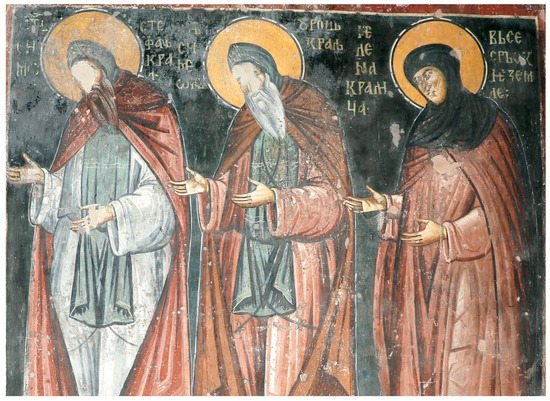
7. Icons
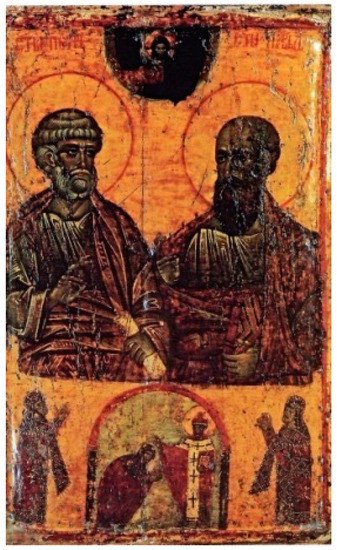
8. The Gračanica Monastery
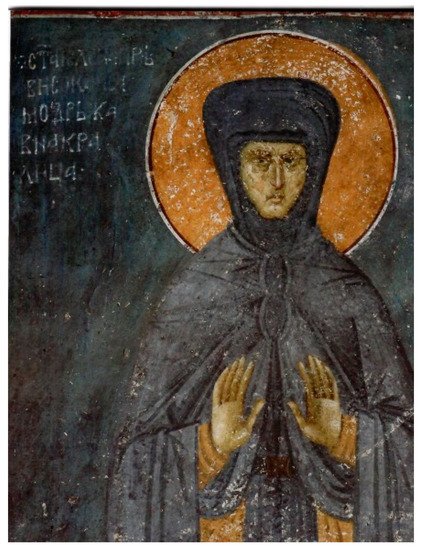
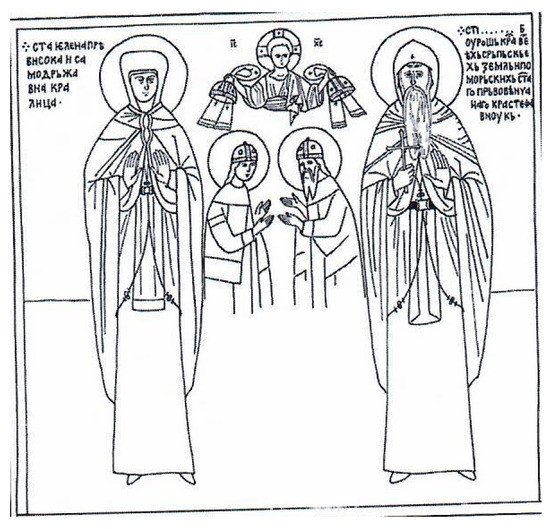
9. Conclusions
References
- McDaniel, G.L. On Hungarian–Serbian Relations in the Thirteenth Century: John Angelos and Queen Jelena. Ungarn Jahrbuch 1982–1983, 12, 43–50.
- Stanković, V. Kralj Milutin (1282–1321) (King Milutin (1282–1321); Freska: Beograd, Serbia, 2012.
- Ječmenica, D. Nemanjići drugog reda (The Second-Rate Nemanides); Filozofski Fakultet: Beograd, Serbia, 2018.
- Ćirković, S. Kralj Stefan Dragutin (King Stefan Dragutin). Račanski Zbornik 1997, 3, 11–20.
- Bubalo, Đ. Jelena kraljica (Helen the queen). In Srpski biografski rečnik (Serbian Biographical Dictioannary); Popov, Č., Ed.; Matica Srpska: Novi Sad, Serbia, 2009; Volume 4, pp. 357–358.
- Erdeljan, J. Two inscriptions from the church of Sts. Sergius and Bacchus near Shkodër and the question of text and image as markers of identity in Medieval Serbia. In Texts/Inscriptions/Images; Moutafov, E., Erdeljan, J., Eds.; National History Museum: Sofia, Bulgaria, 2017; pp. 97–110.
- Komatina, I. Ana Dandolo-prva srpska kraljica? (Anne Dandolo, the First Serbian Queen?). ZMSI 2014, 89, 7–22.
- Radojčić, S. Portreti srpskih vladara u srednjem veku (Portraits of Serbian Rulers in the Middle Ages), 2nd ed.; Republički Zavod Za Zaštitu Spomenika Kulture: Beograd, Serbia, 1997.
- Đurić, J.V. Istorijske kompozicije u srpskom slikarstvu srednjeg veka (Historical composition in Serbian medieval painting). ZRVI 1968, 11, 99–127.
- Popović, D. Srpski vladarski grob usrednjem veku, (Serbian Roayal Tomb in the Middle Ages); Institut Za Istoriju Umetnosti: Beograd, Serbia, 1992.
- Kopije pečata sa povelja srpskih vladara i vlastele XIII–XIV veka (Copies of Seals from the Charters of Serbian Rulers and Nobility of the XIII-XIV Century); Kulić, R. (Ed.) Zbirka Galerije Matice Srpske: Novi Sad, Serbia, 2009.
- Natpisi istorijske sadržine u zidnom slikarstvu (Inscriptions of Historical Content in Wall Painting); Subotić, G.; Miljković, B.; Špadijer, I.; Toth, I. (Eds.) Vizantološki Institute SANU: Beograd, Serbia, 2015.
- Mihailović-Shipley, M. Un Unexpected Image of Diplomacy in a Vatican Panel. In Byzantium in Eastern European Culture in the Late Middle Ages; Rossi, M.A., Sullivan, A.I., Eds.; Brill: Leiden, The Netherlands, 2020; pp. 91–118.
- Dal Santo, G.L. Concordia Apostolorum—Concordia Augustorum: Building a Corporate Image for the Theodosian Dynasty. In East and West in the Roman Empire of the Fourth Century: An End to Unity? Dijkstra, R., Van Poppel, S., Slootjes, D., Eds.; Brill: Leiden, The Netherlands, 2015; pp. 164–179.
- Da Bari Beatillo, A. Historia della vita, miracoli, traslatione e gloria dell’illustrissimo Confessore di Christo, San Nicolò il Magno, arcivescovo di Mira, patrono e protettore della città di Bari, Naples and Palermo; Stamperia di Pietro Coppola: Palermo, Italia, 1642.
- Subotić, G. Kraljica Jelena Anžujska, ktitor crkvenih spomenika u Primorju, (Queen Helen d’Anjou, Founder of Church Monuments in Primorje). Istorijski Glasnik 1958, 1–2, 131–148.
- Todić, B. Gračanica, slikarstvo (Gračanica, Paintings); Prosveta: Beograd, Serbia; Jedinstvo: Priština, Serbia, 1988.
- Todić, B. Kralj Milutin sa sinom Konstantinom i roditeljima monasima na fresci u Gračanici (King Milutin with his son Konstantin and his parents, monks on the fresco in Gračanica). Saopštenja 1993, XXV, 7–23.
- Vojvodić, D. Doslikani vladarski portrti u Gračanici (Additionaly painted portraits of rulers in Gračanica). Niš i Vizantija 2009, VII, 251–265.
- Popović, B. Srpska srednjovekovna vladarska i vlasteoska odežda (Serbian Medieval Royal and Nobility Costume), 2nd ed.; Muzej Srpske Pravoslavne Crkve: Beograd, Serbia, 2021.
